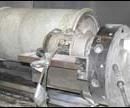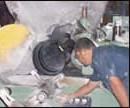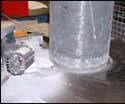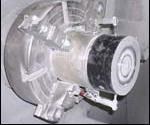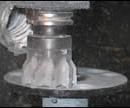Machining Composites By Conventional Means
Composites machining is dusty, messy and hard on tools. But this company accepts these difficulties, and machines the material using standard metalworking processes and equipment.
Share



Shops that have never cut thermoset composites—material that is approximately one-fifth the density of steel—might not think it would be very tough. The folks at Amalga Composites in West Allis, Wisconsin, have seen shops with similar attitudes give it a shot. Many times, though, a shop’s first time machining composites is also its last time. According to Dr. Jack DeLuca, president and COO of Amalga Composites, there are two common reasons why shops could go one-and-out versus composites.
It may be that the shop applies cutting strategies appropriate for aluminum or steel alloys, which simply won’t cut it for effectively machining abrasive composites. It also could be as simple as an operator’s flat-out refusal to deal with the dust and mess created when a cutting tool engages a part comprised of epoxy resin and fiber reinforcement.
Amalga Composites’ specialty is producing fiber-wound products, such as drive shafts, rollers, pressure vessels and tanks. It also compression-molds end caps for tubing products, as well as parts for aerospace, fluid power and other industries. Half of its manufacturing process is dedicated to winding or molding raw composite components; the other half is dedicated to machining those parts.
The company has determined that virtually any machining operation that can be performed on a metal part can also be performed on a composite part. In addition, the milling, turning, drilling and grinding it carries out are done using traditional metalworking machines and tools that were not necessarily designed with composites in mind. As with machining any type of material, the key is matching the process to the part by applying cutting techniques and tooling best suited for composites. It’s really no different than adapting one’s machining approach when switching from an aluminum part to a steel part.
During the last 10 years, Amalga Composites has seen a steady increase in the number of customers requesting that their parts be fully machined; parts that might just require assembly, painting or balancing. Dr. DeLuca and Gregg Piper, the company’s vice president of engineering, offered Modern Machine Shop a glimpse into the type of machining work that’s required for their company’s styles of composite parts. They also clued us in as to some of the methods they’ve found effective for machining such an abrasive material.
Material Differences
There are two types of fiber reinforcement that the company uses for its composite products—glass and carbon. Glass is less expensive than carbon and is used for applications in which affordability and strength are required. Carbon is typically chosen for its stiffness—a carbon fiber part can be as stiff as steel at one-fifth of steel’s weight. There aren’t major machineability differences between the two fibers. Glass is more abrasive than carbon, which causes tools to wear faster. Carbon is more brittle than glass, and it makes a finer dust that can pose larger cleanliness issues.
The company’s raw composite tubes are created on precision chrome-plated mandrels, in which resin-coated fiber reinforcement is overlaid in cross-hatching layers (called lamina). Tubing wall thickness might range from 1/8 inch to 3 inches, depending on the application. A mold release agent applied to the mandrel aids in removing the tubes after curing. The raw tubes, which can vary in diameter from 1 inch to 42 inches, are then typically cut to length and staged for secondary machining operations.
Fiber-wound products are analogous to wood, because both have a grain, grain direction and different strengths depending on those grain directions. Amalga Composites is able to design attributes into the filament-wound parts to facilitate secondary machining processes, as the material reacts differently to machining depending on the type of fiber reinforcement, winding angles and resin formulas.
The company has found that it is typically easier to cut parallel to the length of the fiber, rather than across the fiber. That’s because the fiber, which essentially fractures as it is being cut, cleaves better along its length versus 90 degrees to the fiber. This leads to a smoother cut with less possibility for chipping.
The fiber reinforcement is the reason why composites are more stable than unfilled plastics such as nylon. So while bounce-back (deformation as a result of tool pressure) must be accounted for when machining non-reinforced plastics, it is not as big a problem for composites.
Here’s an overview of machining processes and equipment that the company applies in machining composites.
Tooling—Composites are inherently abrasive and cause cutting tools to wear rapidly. Depending on the circumstances, high speed steel (HSS), carbide and diamond-coated cutting tools are all viable choices for machining composites. Regardless of the cutting tool’s material or coating, its geometry should have a positive rake angle. A positive cutting edge tends to knife its way into the material. This shears the fibers more effectively than negative or neutral profiles that rub or drag across the material.
HSS, the least expensive of the three tooling materials, might be appropriate for very short runs where overall tool life isn’t as critical as a high-volume job. Carbide falls between HSS and diamond in terms of tool life and wear resistance, and it is used accordingly. Diamond-coated tools are the cutters of choice for most composites machining operations at Amalga Composites, as they offer the best wear resistance over many cutting operations.
It is important to accurately track a tool’s machining time no matter what type of tool material is used. HSS, carbide and diamond tools all wear down and shrink in diameter; an operator can trend and react to this. When a tool begins to lose its sharpness, it tends to catch fibers without breaking them, pulling and unwinding fibers from the part instead of cutting them. It takes diligence on a machine operator’s part to know what a tool’s predicted effective life is and change the tool before dulling occurs (usually after a certain number of machining operations are performed). In machining composites, tool life is predictable as long as there hasn’t been a change in the part’s resin, fiber or fiber-winding angle.
Coolant—The choice to machine wet or dry largely depends on the machining operation. Composite materials have low thermal conductivity, so coolant will be used for high-heat cutting operations to reduce the chance of degrading the part’s resin. Coolant also keeps cutting tool edge temperatures under control, which is especially important for diamond-coated tools to prevent the coating from releasing from the tool’s substrate. In addition to cooling cutting surfaces, coolant cleans a tool’s cutting surface, so grinding wheels, for example, won’t become loaded with material.
Coolant aids in dust control for operations such as centerless grinding that would create a tremendous amount of particulate. With an operation such as single-point turning, though, the dust is released in a finite area, which allows easy collection by a vacuum system installed at the machine. Those operations will be performed dry unless workpiece or tool frictional heating is an issue.
Pure water is the most common machining coolant. If a machine will be cutting both composites and metals, a water-soluble fluid with 1 to 2 percent of rust inhibitor is used. It is important to use a water-soluble coolant, because that won’t adversely affect paint bonding as an oil-based fluid would. (The porous surface of a machined composite part has numerous nooks and crannies where coolant oils could hide.) Oil- or solvent-based coolants can also wick along exposed fibers, and they won’t evaporate as pure water does.
While coolant helps contain dust, the resulting coolant/dust mixture is a slurry-like consistency. Composite dust is inert, so it can be landfilled. However, the landfills can’t deal with the excess water. Amalga Composites has equipment that removes water from the mixture, leaving behind a clay-like material that can be landfilled.
Workholding—To support long, thin tubes that require turning operations, headers that are just a few thousands of an inch smaller than a tube’s bore may be temporarily installed into either end for chucking purposes. Shorter tubes, perhaps those requiring only a facing, drilling or turning operation, might be mounted on a steel extension gripped by the lathe’s chuck. Toggle clamps on the extension hold the workpiece in place with sufficient force for the machining operation, but not so much force as to deform the part. Care must be taken not to scratch a tube’s inner surface when it is being held by its ID. The solution can be as simple as adding a layer of duct tape over chuck jaws.
Compression-molded parts are more prismatic than tubes. They are made from stacking sheet molding compound in a mold, and then heating and compressing the part into shape. These parts generally require workholding methods common to metal parts of similar geometries.
Chamfering—Highly accurate shouldering and chamfering operations might be performed on one of the company’s CNC lathes. Another alternative, depending on part quantities and tolerances, is a machine that resembles a router but uses a 23,000-rpm air motor to spin a solid carbide burr. A chamfering operation on this piece of equipment takes roughly 1 minute, versus 5 minutes on one of the lathes.
Turning—The company has a few lathes, including a small slant-bed machine from Okuma (Charlotte, North Carolina) and a larger CNC lathe with live tooling from Toolmex (Natick, Massachusetts). The Toolmex machine is used for both long and short tubes. For tubing parts, machining operations include turning to diameter, grooving, facing ends, boring and slotting operations. Regardless of the machine, the company shoots for a surface speed of approximately 300 feet per minute when turning. Most parts are turned using diamond inserts.
Milling—Milling operations are typically performed on compression molded parts, rather than tubes. In general, milling techniques are similar to those used for marine brass, which require sharp tools and a positive rake angle. Machining speeds and feeds are three times faster (900 feet per minute) for compression molded parts because the material makeup is different from fiber-wound parts. The fiber volume of a compression-molded part is typically 60 percent, and the fibers are relatively short (approximately 1 inch in length). This allows easier cutting than a tube that has fibers wound continuously throughout the part. The tubing parts also have higher fiber content (70 percent), so much more fiber must be cut.
Face milling is a common operation for compression-molded parts. One example is a flange that is installed in the end of a drive shaft (see photo above). This component requires face milling to ensure flatness, as it will be bolted to a gearbox. Milling is performed using a face mill with diamond inserts from Valenite (Madison Heights, Michigan) on a tree vertical machining center (VMC). The company is investigating other milling machines for multiple-axis work.
The general rule of thumb for milling composites is to use sharp tools at high spindle speeds and low feed rates.
Drilling—Hole drilling is a common operation for the company’s tube parts, and it is performed on both the lathes and on the VMC. Clean holes are required for the tubing section of pressure vessels, for example, to accommodate a bulkhead fitting for condensate drain or other fittings. Supporting a tube’s inner wall is critical when drilling through the thickness of a tube to prevent delamination, or separation of the fiber layers. A wooden or plastic plug temporarily installed inside the tube is typically used to provide requisite wall support.
The best drilling results are obtained using diamond-tipped tools with polished flutes operating at (not surprisingly) high speeds and slow feeds. Over the years, the company has found that thin-web drills with helix angles of 10 to 50 degrees, clearance of 9 to 20 degrees and point angles of 60 to 120 degrees work best to limit chip packing and overheating.
As with other materials, drilling speed should be adjusted per the size and depth of hole—typically the bigger the hole, the slower the drill speed should be in order to maintain consistent feet per minute for the tool.
Grinding—For most tubing products, their ID is more critical than the OD (the precision mandrel provides the accurate ID). Rollers, however, do require a precise OD. The company’s Cincinnati centerless grinding machines were modified to increase workpiece capacity from 6 inches to 22 inches to accommodate large rollers. Tubes that are larger than 22 inches in diameter will be ground on a large-capacity lathe. Nearly all tubing products are centerless ground using plain water for coolant and either silicone carbide or aluminum oxide wheels.
Centerless grinding offers not only OD accuracy, but also a fast way to remove a lot of material. A grinding operation can take 0.01 to 0.025 inch for each pass. This is more than would be possible if grinding a steel tube because the composite material is less dense, allowing deeper passes. However, because the stiffness of fiberglass in the radial direction is 1/10 that of steel, there is some deformation, which means the composite tube OD can’t be as accurate as steel.
So What About The Dust?
Dr. DeLuca points to two myths regarding the machining of composites—1) you’ll ruin your machines and 2) the dust is dangerous to the operator. Neither is true. A machine running composites or any other material will only be ruined because of cutting debris if it is not cleaned on a regular basis. More frequent changes to filters on the electronics cabinets are recommended, though (monthly instead of twice a year).
The dust generated by machining composites is considered a nuisance dust (as is sawdust). While glass fiber is itchy, it’s not like asbestos fiber, which can attach to a person’s lungs. It is simply a matter of getting used to exposure to the dust. One of Amalga Composites’ current machine operators who had an allergic reaction to the type of coolant used at a previous shop isn’t bothered at all with composites dust.
Keeping Busy
Amalga Composites is busier now than it has ever been. The pace is not likely to slow down anytime soon, as composites are gaining greater acceptance for applications that previously used steel or aluminum. This is because of the material’s resistance to corrosion and chemicals. To make sure the company keeps up with greater demand, it has started implementing lean manufacturing techniques such as 5S to speed and streamline its manufacturing processes.
Read Next
OEM Tour Video: Lean Manufacturing for Measurement and Metrology
How can a facility that requires manual work for some long-standing parts be made more efficient? Join us as we look inside The L. S. Starrett Company’s headquarters in Athol, Massachusetts, and see how this long-established OEM is updating its processes.
Read More










